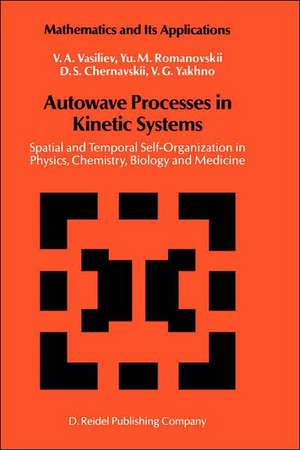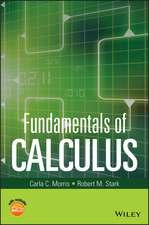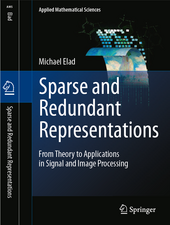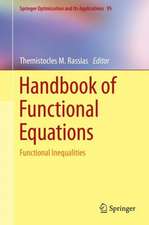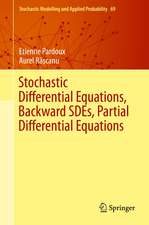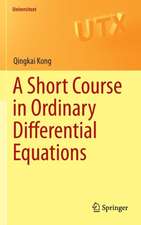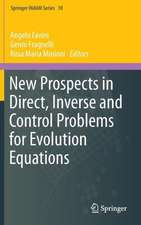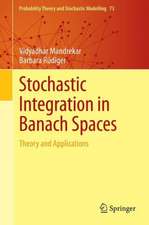Autowave Processes in Kinetic Systems: Spatial and Temporal Self-Organisation in Physics, Chemistry, Biology, and Medicine: Mathematics and its Applications, cartea 11
Autor V. a. Vasiliev, Yu.M. Romanovskii, D.S. Chernavskii, V. G. Yakhnoen Limba Engleză Hardback – 31 iul 1987
| Toate formatele și edițiile | Preț | Express |
|---|---|---|
| Paperback (1) | 386.81 lei 6-8 săpt. | |
| SPRINGER NETHERLANDS – 2 oct 2011 | 386.81 lei 6-8 săpt. | |
| Hardback (1) | 394.12 lei 6-8 săpt. | |
| SPRINGER NETHERLANDS – 31 iul 1987 | 394.12 lei 6-8 săpt. |
Din seria Mathematics and its Applications
- 15%
 Preț: 499.42 lei
Preț: 499.42 lei -
 Preț: 367.83 lei
Preț: 367.83 lei -
 Preț: 480.62 lei
Preț: 480.62 lei -
 Preț: 381.89 lei
Preț: 381.89 lei - 23%
 Preț: 321.52 lei
Preț: 321.52 lei -
 Preț: 435.39 lei
Preț: 435.39 lei - 20%
 Preț: 371.26 lei
Preț: 371.26 lei -
 Preț: 435.59 lei
Preț: 435.59 lei - 22%
 Preț: 333.11 lei
Preț: 333.11 lei - 15%
 Preț: 459.13 lei
Preț: 459.13 lei - 22%
 Preț: 321.53 lei
Preț: 321.53 lei - 18%
 Preț: 1055.51 lei
Preț: 1055.51 lei -
 Preț: 432.50 lei
Preț: 432.50 lei -
 Preț: 427.71 lei
Preț: 427.71 lei - 13%
 Preț: 351.91 lei
Preț: 351.91 lei -
 Preț: 356.64 lei
Preț: 356.64 lei - 15%
 Preț: 642.83 lei
Preț: 642.83 lei -
 Preț: 392.97 lei
Preț: 392.97 lei - 15%
 Preț: 651.67 lei
Preț: 651.67 lei - 15%
 Preț: 642.00 lei
Preț: 642.00 lei - 15%
 Preț: 647.59 lei
Preț: 647.59 lei -
 Preț: 389.49 lei
Preț: 389.49 lei - 15%
 Preț: 652.17 lei
Preț: 652.17 lei - 20%
 Preț: 651.57 lei
Preț: 651.57 lei - 15%
 Preț: 650.19 lei
Preț: 650.19 lei -
 Preț: 382.36 lei
Preț: 382.36 lei -
 Preț: 392.97 lei
Preț: 392.97 lei - 15%
 Preț: 657.39 lei
Preț: 657.39 lei - 15%
 Preț: 658.37 lei
Preț: 658.37 lei
Preț: 394.12 lei
Nou
Puncte Express: 591
Preț estimativ în valută:
75.42€ • 78.45$ • 62.27£
75.42€ • 78.45$ • 62.27£
Carte tipărită la comandă
Livrare economică 15-29 aprilie
Preluare comenzi: 021 569.72.76
Specificații
ISBN-13: 9789027723796
ISBN-10: 9027723796
Pagini: 272
Ilustrații: VI, 262 p.
Dimensiuni: 155 x 235 x 20 mm
Greutate: 0.56 kg
Ediția:1987
Editura: SPRINGER NETHERLANDS
Colecția Springer
Seria Mathematics and its Applications
Locul publicării:Dordrecht, Netherlands
ISBN-10: 9027723796
Pagini: 272
Ilustrații: VI, 262 p.
Dimensiuni: 155 x 235 x 20 mm
Greutate: 0.56 kg
Ediția:1987
Editura: SPRINGER NETHERLANDS
Colecția Springer
Seria Mathematics and its Applications
Locul publicării:Dordrecht, Netherlands
Public țintă
ResearchCuprins
1 Autowave processes and their role in natural sciences.- 1.1 Autowaves in non-equilibrium systems.- 1.2 Mathematical model of an autowave system.- 1.3 Classification of autowave processes.- 1.4 Basic experimental data.- 2 Physical premises for the construction of basic models.- 2.1 Finite interaction velocity. Reduction of telegrapher’s equations.- 2.2 Nonlinear diffusion equation. Finite diffusion velocity.- 2.3 Diffusion in multicomponent homogeneous systems.- 2.4 Integro-differential equations and their reduction to the basic model.- 2.5 Anisotropic and dispersive media.- 2.6 Examples of basic models for autowave systems.- 3 Ways of investigation of autowave systems.- 3.1 Basic stages of investigation.- 3.2 A typical qualitative analysis of stationary solutions in the phase plane.- 3.3 Study of the stability of stationary solutions.- 3.4 Small-parameter method.- 3.5 Axiomatic approach.- 3.6 Discrete models.- 3.7 Fast and slow phases of space-time processes.- 3.8 Group-theoretical approach.- 3.9 Numerical experiment.- 4 Fronts and pulses: elementary autowave structures.- 4.1 A stationary excitation front.- 4.2 A typical transient process.- 4.3 Front velocity pulsations.- 4.4 Stationary pulses.- 4.5 The formation of travelling pulses.- 4.6 Propagation of pulses in a medium with smooth inhomogeneities.- 4.7 Pulses in a medium with a nonmonotonic dependence v = v(y).- 4.8 Pulses in a trigger system.- 4.9 Discussion.- 5 Autonomous wave sources.- 5.1 Sources of echo and fissioning front types.- 5.2 Generation of a TP at a border between “slave” and “trigger” media.- 5.3 Stable leading centres.- 5.4 Standing waves.- 5.5 Reverberators: a qualitative description.- 6 Synchronization of auto-oscillations in space as a self-organization factor.- 6.1 Synchronization inhomogeneous systems.- 6.2 Synchronization in inhomogeneous systems. Equidistant detuning case.- 6.3 Complex autowave regimes arising when synchronization is violated.- 6.4 A synchronous network of auto-oscillators in modern radio electronics.- 7 Spatially inhomogeneous stationary states: dissipative structures.- 7.1 Conditions of existence of stationary inhomogeneous solutions.- 7.2 Bifurcation of solutions and quasi-harmonical structures.- 7.3 Multitude of structures and their stability.- 7.4 Contrast dissipative structures.- 7.5 Dissipative structures in systems with mutual diffusion.- 7.6 Localized dissipative structures.- 7.7 Self-organization in combustion processes.- 8 Noise and autowave processes.- 8.1 Sources of noise in active kinetic systems and fundamental stochastic processes.- 8.2 Parametric and multiplicative fluctuations in local kinetic systems.- 8.3 The mean life time of the simplest ecological prey-predator system.- 8.4 Internal noise in distributed systems and spatial self-organization.- 8.5 External noise and dissipative structures — linear theory.- 8.6 Nonlinear effects — the two-box model.- 8.7 Wave propagation and phase transitions in media with distributed multiplicative noise.- 9 Autowave mechanisms of transport in living tubes.- 9.1 Autowaves in organs of the gastrointestinal tract.- 9.2 Waves in small blood-vessels with muscular walls.- 9.3 Autowave phenomena in plasmodia of Myxomycetes.- Concluding Remarks.- References.
